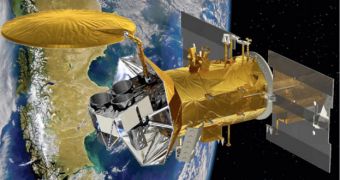Experts at NASA say that their newest ocean salinity-monitoring spacecraft will launch to the skies on Friday, June 10, at around 10:20 am EDT (1420 GMT). If successful, the mission will allow us to understand how Earth's oceans control the planet's climate in more exquisite detail.
The spacecraft will be carried to orbit aboard a Delta 2 rocket, which will launch from the Vandenberg Air Force Base (VAFB), in California. Originally, SAC-D was supposed to take off today, June 9, but NASA mission managers announced the 24-hour delay last night.
A series of software issues have been discovered in the flight program controlling the Delta 2 delivery system, and experts spent the night fixing them. Despite their swift progress, they couldn't possibly have gotten the rocket back online in time.
Once launched, SAC-D (which is short for Satélite de Aplicaciones Científicas-D) will join a 13-strong NASA Earth-monitoring satellite constellation. All these instruments keep a watchful eye on various natural processes from above.
SAC-D was built by the Argentine space agency (CONAE), but its main instrument, Aquarius, was developed by experts at the NASA Goddard Space Flight Center (GSFC), in Greenbelt, Maryland, and the NASA Jet Propulsion Laboratory (JPL), in Pasadena, California.
Understanding global precipitation patterns, oceanic evaporation and water circulation will be one of the primary objectives the new mission will have. It will also investigate ocean salinity within the first centimeter (0.4 inch) of the ocean surface.
If experts are able to figure out how Earth's water cycle works in more detail, then they could improve their computer models so that they better reflect reality. Though largely ignored by scientists, ocean salinity plays a critical role in guiding our planet's atmosphere.
“In order to study these interactions between the global water cycle and the ocean circulation, the piece that we're missing is ocean salinity. And that's the gap that Aquarius is designed to fill,” said the principal investigator for the Aquarius instrument, Earth and Space Research scientist Gary Lagerloef.
“What the satellite does is give you a systematic measurement over the whole globe,” says the expert, one of the first to begin studying ocean salinity. He says that SAC-D/Aquarius will not be working alone.
NASA plans to deploy a vast array of capabilities to complement the mission, including buoys, free-floating platforms, autonomous underwater vehicles, underwater gliders, research ships and commercial vessels, Space reports.
The data Aquarius will collect will be added to those already being produced by the Soil Moisture and Ocean Salinity (SMOS) satellite, which the European Space Agency (ESA) launched in November 2009.

 14 DAY TRIAL //
14 DAY TRIAL //